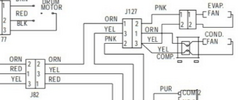Am I allowed to hate whomever drew this schematic? In order to avoid crossing lines, the pins on pairs of connectors are shuffled. Pin 2 on one side connects to 2 on the other side....but they don't line up with each other. In this case, two pairs of connectors in line are shuffled.
This particular connector also has a problem where a 13 pin connector has a pin 14 in one place.
Sure, the schematic looks neat, but trying to follow signals from one end to the other is a mind-numbing experience!

This particular connector also has a problem where a 13 pin connector has a pin 14 in one place.
Sure, the schematic looks neat, but trying to follow signals from one end to the other is a mind-numbing experience!

